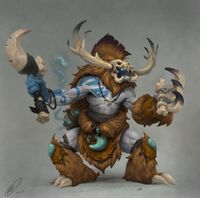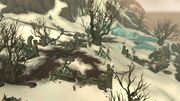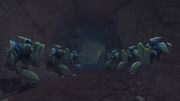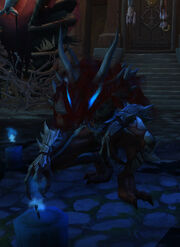| Drust | |
|---|---|
 Concept art of a Drust shaman | |
| Faction/Affiliation | Independent, Heartsbane Coven, Thornspeakers |
| Character classes | Evoker, Druid, Warrior |
| Racial capital | Thros |
| Racial leader(s) | |
| Homeworld | Azeroth |
| Area(s) | Thros, Drustvar, Tiragarde Sound, Fate's End (Kul Tiras), Ardenweald |
| Sources: Battle for Azeroth | |
The Drust were a population of seafaring vrykul who some time after the Sundering settled on the island of Kul Tiras.[1] They wielded powerful death magic and mainly lived in Drustvar, but also resided in several areas of Tiragarde Sound and to lesser extent Stormsong Valley; to this day, their ruins and ancient roads can be seen throughout the island. When human sailors from Gilneas arrived in Kul Tiras around 2,700 years ago, the Drust king Gorak Tul led his people into war against the human settlers. However, not all Drust agreed with the war, and the druidic Thornspeakers left Drust society to side with the humans.[2]
Gorak Tul eventually lost the conflict, and his Drust were almost all slain by the human invaders. However, the Drust remained as spirits in the dark realm of Thros and have since slowly been trying to make their way back to the mortal world. During the Fourth War, they made a pact with Lady Waycrest, helping her save her dying husband in exchange for assisting them. On the Drust's part, all they desired was vengeance against her people.[3] Following this pact, Waycrest began wielding Drust magic and formed the Heartsbane Coven, an order of witches who began terrorizing the people of Drustvar and worked to summon Gorak Tul back into the realm of the living.
Gorak Tul's efforts on Kul Tiras were eventually thwarted, but the Drust can also be found in large numbers in the Shadowlands, where they are attempting to invade the realm of Ardenweald from Thros.
Background

Drust ruins in Drustvar.
Some vrykul settlements were scattered prior to the Great Sundering. After the Sundering, various vrykul tribes set out for the seas, and one such population of seafaring vrykul settled on Kul Tiras.[1]
Before the reign of Gorak Tul, the Drust practiced druidism. In the opinion of the druids, Gorak Tul's twisted ways brought disgrace to the Drust.[4] Gorak Tul, their sorcerer king, was the one who perverted the druidic rituals of the Drust and set their people upon the path of death and domination.[5] The Drust fought many enemies over their history, including beings that looked like themselves or great beasts, smaller beings that resembled gnomes in stature, and naga.[6]
Around 2,700 years ago, humans from Gilneas arrived on the island, which they would later call Kul Tiras.[7] The humans tried for peace with the Drust, but the latter went to war immediately,[8] aggressively launching raids against the humans' fledgling hamlets from Drustvar.[9] The Drust barbarians glorified the slaughter, attacking unarmed civilians.[8] It was during this war that the Drust tapped into Thros, the Blighted Lands.[1]
Only a few of the Drust tolerated new neighbors.[8] A member of the druidic Thornspeakers by the name of Sef Iwen protested the brutality of Gorak Tul, stating that the Drust could live in harmony with the humans if they tried. Tul gave Iwen the choice to either submit or "hide in the woods forever". Iwen chose the latter, believing Tul meant exile, but instead the king tore her soul from her body, cursing her to forever haunt the woods later called the Glenbrook Hunting Grounds and using her death as an example to scare other dissidents into submission.[10] This act of brutality alongside the others that Tul continued to enact upon the humans ultimately led to the Thornspeakers leaving the Drust to join Kul Tiran society. Some of the humans' Kul Tiran descendants heard the call of the wilds and sought to learn the ancient ways, and so the Drust Thornspeakers taught them the ways of druidism.[2]

The Drust assaults carried on for many years until the ancestors of House Waycrest decided something had to be done and began a war against the Drust. But though the Waycrests were hearty folk, the Drust's death magic was strong and the humans began to lose the war.[9] The Waycrests researched their magic and created the Order of Embers to fight them.[11] To counter the Drust magic, the Order of Embers used weapons of silver and rowan wood, the latter of which is not found in Drustvar.[12] A complex alchemical solution called Liquid Fire was a weapon used to "burn away the Drust".[13]
In time the Drust would be forced to withdraw as they lost numbers to the human settlers. As the war went on, the desperate Drust called onto dark powers. Unbeknownst to them, they had reached the Emerald Nightmare.[1] Their fallen warriors would find refuge in Thros, an offshoot of the Nightmare which they named differently as they were not aware of what the Nightmare was.[1] When their great leader Gorak Tul ran out of living warriors, he conducted a ritual to create stone constructs to fight for him as part of his desperation to win. The Drust settlement of Gol Osigr would become the place of their final defeat. Colonel Arom Waycrest, who later became the first Lord of Drustvar, led the humans' final assault on the Drust and stabbed Gorak Tul himself. As he was stabbed Gorak Tul's power was broken and, with it, his connection to his stone constructs which shattered.[8] But though wounded and broken, Gorak Tul did not die.[14]
In modern times, the story has been warped. The modern Kul Tirans believe that the stone constructs were used for a longer period than just near the end of the war, that Arom had killed Gorak Tul, and that Gorak Tul's living army fell soon after his death instead of earlier on.[8]
The Drust would live on as spirits, trying to return to the physical world.[3] The Waycrests had wiped out the Drust, but could not destroy Gorak Tul. For countless years he waited to enact his vengeance from within Thros,[15] until Lady Waycrest provided the means.[16]
Battle for Azeroth

Stricken with grief due to her ailing husband Arthur, Lady Waycrest called out to any power that could save him. Gorak Tul answered her cry and promised that death would never part the couple, for a price.[17] Gorak Tul taught the Drust's ancient death magic[18] to Lady Waycrest, who in turn formed the Heartsbane Coven. The coven's magic awakened the remaining stone constructs[9] and stirred the Drust's spirits, drawing them back to fight once more as skeletons.[19] Other Drust spirits were put into wicker constructs.[20] During the events of the Kul Tiran civil war, the Heartsbane Coven of witches had started to go beyond constructing dark constructs, by conjuring the Drust physically through nightmarish rituals. They were stopped by the Order of Embers before they could be unleashed upon Drustvar.[21] Gorak Tul himself summoned many twisted Drust fiends during his confrontation with mortals at Waycrest Manor, and while the Order of Embers had stopped them from being unleashed upon Drustvar, several could still be found stalking the area.
But Lady Waycrest was merely a vessel for Gorak Tul's power, and her death opened the Rupture, the doorway for the Drust to enter Azeroth.[16] At the Rupture Gorak Tul was able to raise his people from the dead, but he was slain nonetheless. However, upon his death Gorak Tul revealed that it was only a vessel and he still existed in the Blighted Lands. Even so, the Heartsbane Coven was broken and Drustvar was released from Gorak Tul's power.
When Jaina Proudmoore was exiled to Fate's End by her own mother Katherine, Gorak Tul captured her and dragged her into Thros.[22] When the people of Kul Tiras sought to rescue Jaina and turned to the Drust druid Ulfar for help, Gorak Tul attacked him and the Thornspeakers to whom he had taught the Drust's ways. Gorak Tul was not happy that Ulfar had shared their gifts with the humans, but Ulfar himself saw Gorak Tul's twisted ways as bringing disgrace to the Drust.[4] Later, the Herald of Gorak Tul announced the return of the Drust's master to Katherine Proudmoore on her quest to find Jaina. Within Thros, Jaina was being tormented by memories of her past. After she was saved by her mother, Jaina and the adventurer slew Gorak Tul in his own domain.[23]
Shadowlands

![]() Please add any available information to this section.
Please add any available information to this section.
With the drought weakening the guardians of Ardenweald, the ancient Drust have seized the opportunity to invade from their nightmarish realm of Thros. The decaying groves of Ardenweald are what drew the Drust there.[24] Using their twisted form of druidism to feed upon the dying groves, the Drust grow stronger with every wildseed that perishes. Though relatively few in number, the Drust are using dark rituals to pull the native fae into their forces.[25] Cursed to exist outside the cycle of life and death, the Drust now seek to circumvent their fate using Ardenweald's mechanisms of Rebirth.[26] According to Marasmius, the Drust had invaded Ardenweald before.[27]
To save the sylvar Gweyir from a Drust curse, the adventurer is told by Ysera to work with Ulfar, who she once knew[28]. Ulfar directs the adventurer to his long dead former teacher Kivarr with a fetish that contains Gorak Tul's power, who after saving her agrees to help but requires additional reagents, including a plant called nox root that only grows in Drust corrupted soil, and some other reagents from Ardenweald.[29][30][31][32][33] Reagents from the Shadowlands are necessary in attempting to break a Drust curse.[34]
Culture notes

Rows of Drust constructs in Gol Var.
- Tomes were often kept by the strongest of the Drust, preserving the incantations of their magics and serving as conduits for harnessing their power. Scholars have tried to translate the ancient language transcribed within these tomes, only to find themselves going mad as they furthered their understanding of what had been written.[35]
- The Drust would often use various animals in their rituals, mostly for their organs. Bonesaws were pivotal in breaking through some of the larger animals' rib cages in order to extract the heart of the beast.[36]
- When the Drust wished to enchant the minds of their enemies, or prey, they would often do so subtly by leaving small tokens around their targets. Curious objects, when focused on by the holder, would summon a haunting vision of a dancing spectre. This spectre would entrance all who watched it, rendering them docile and easy to dispatch.[37]
- Many tools have been discovered that the Drust used in their rituals. One such tool was a sickle, used for ripping through the bellies of their sacrifices, spilling their entrails and allowing the Drust to use their organs in dark rituals.[38]
- Used to inflict doubt in the enemies of the Drust, this fetish was paramount for twisting the minds of their enemies. Those afflicted would question their motivations, their ideals, or their courage and would often find themselves at the end of a Drust blade before finally rediscovering their resolve.[39]
- Used for both combat and ancient ceremonies, the blades of the Drust are fearsome objects. When wielded by a Drust, this blade can quickly find it's way into any vital organ within a matter of seconds.[40]
- As the Drust became more skilled at trapping souls within objects, so did they become more adept at creating constructs of death in which to trap the souls. Revenants are amongst the fiercest of these creatures. Their bodies constructed from pieces that can no longer decompose, these creatures never tire and will hunt their prey for all eternity.[41]
- When the Drust were first learning to attach souls into constructs, they used the bones of their dead as hosts. Once the ritual was complete, these fetishes were said to glow with an eerie blue glow, presumably with the essence of the soul's power made manifest.[42]
- When a soul is called from the afterlife, it is free to roam the material realm if it is not restrained within moments of its arrival. The Drust created prisons for these souls for later use in their dark rituals, during which time the soul would suffer within, become a twisted version of what it once had been.[43]
- Since time immemorial, the Drust have used runes to shape their magics. This remains true of the spells woven by Gorak Tul and his ilk.[44]
- The Drust's bodies and skeletons are marked with magical runes in Drust language.[19]
- Drust sacrifices included great horned creatures, possibly stags but possibly something else.[45]
- The Drust worshiped a great tree, Gol Inath.[46]
- Drust shrines to various creatures can be found throughout Drustvar. This includes a stag shrine at Gol Osigr, possibly in reverence to Athair. Numerous plinths can also be found near Greenstalker and a final shrine can be found at Vadekius's Rest, depicting a dragon. This may have indicated the worship of these creatures.
- The Drust are able to control others' minds by placing masks on them.[47] With enough time, the masks will transform their victims to be twisted by Thros just like the Drust.[48]
Variants

A Blighted Horror, an example of the most common form of the Drust.
The Drust come in several forms despite having been descended from vrykul. Concept art depicts the Drust as appearing extremely similar to Vrykul, albeit with pale skin and blue eyes. The Drust spirit, Sef Iwen, uses a vrykul female model, though she is the only Drust to be depicted in such a manner. The only other friendly Drust, Ulfar, does not ever leave his bear form; thus making his humanoid form's appearance unknown. The images of the Drust that appear at Gol Osigr are tall pale humans in a mix of primal looking armor; though this design is unique to their appearance here.
In the case of Gorak Tul and several other Drust spirits, they appear similar to their vrykul forebears, albeit with tree-like growths and skin grafts. This may predate their exposure to Thros, as their druidic forms show similar aesthetics, though in Gorak Tul's case this is notably enhanced. This includes warped eyes and a sinister mouth. This variant appears to be restricted to more powerful Drust, as from here their form begins to degrade.
The second variant of Drust is a Drust 'treeman' which is far more common. Introduced in World of Warcraft: Shadowlands, this form seems to be an in-between for the previous form and the next. For this form, the tree grafts have taken over the bulk of the Drust's body, their head nearly consumed by it, and their body mostly made of this material. Their hair has also been replaced with long flowing locks of Thros' energy. They are notably more scrawny, as opposed to the vrykul-esque build of their leaders.
The third variant, and most common, are the Drust horrors. These fiends crawl along the ground and hold little resemblance to their former selves, their skulls overtaken by the tree graft and morphed into a hideous creature, as well as their bodies being twisted out of their human-like appearance. Their feet and hands have been morphed into that of some sort of creature and the Thros energy has entirely taken over their heads. They clamor along the ground similarly to geists, able to climb sheer surfaces. They are still capable of speech and spell casting and are the only living invocation of a Drust seen on Azeroth outside of Gorak Tul or the Thornspeakers.
Several other variants exist, such as a female-only variant found in the Shadowlands that bears a striking resemblance to that of the Matrons. These women have no grafts or tree appendages, though their hair, feet, and fingers are stained with the energy of Thros. Undead Drust still wander the areas around their former lands in Drustvar, though they are all skeletal. Lastly, the Drust invoked by the Heartsbane Coven that did not arrive as horrors would have their spirits possess wooden golems made in the shape of their former bodies.
Known
Notable
Types
 Awakened Dead
Awakened Dead Drust Evoker
Drust Evoker Fallen Defender
Fallen Defender Vengeful Bones
Vengeful Bones
 Blighted Deciever
Blighted Deciever
 Blighted Fiend
Blighted Fiend
 Blighted Haunter
Blighted Haunter
 Blighted Horror
Blighted Horror
 Blighted Monstrosity
Blighted Monstrosity
 Deathtouched Slaver
Deathtouched Slaver
 Gloom Horror
Gloom Horror
Items
Notes and trivia
- Ardenweald in the Shadowlands is deeply connected to the Drust who come from the land of death.[49] The death and domination that Gorak Tul tapped into seems to be tied to the Shadowlands, given a curse derived from this power can only be broken in part with reagents from the Shadowlands.[50]
- The only two examples of living, non-resurrected, Drust are remarkably long-lived. Ulfar has been alive since the time of the war with Arom Waycrest, as has Gorak Tul. While possibly sustained by magic in both accounts, they are both over two thousand years old.
- It was only confirmed at a later point that the Drust were vrykul.[1] Prior to that, several elements hinted at it. The concept art shown at BlizzCon 2017 resembled a tattooed, slouched vrykul wearing animal fur and limbs.[51] The Drust architecture concept art also greatly resembled vrykul architecture from Wrath of the Lich King concept artwork,[52][53] and their buildings and structures re-use the Stormheim vrykul's Bonespeaker building models, and are etched with the same runes and patterns as the vrykul's. Their giant and revenant stone constructs are also engraved with vrykul runes and patterns.
- In the Battle for Azeroth alpha, during
 [20-60] Pieces of History Drust used a mix of human and vrykul models wearing primitive outfits. In the final version of the game, strangely they use pale human models.
[20-60] Pieces of History Drust used a mix of human and vrykul models wearing primitive outfits. In the final version of the game, strangely they use pale human models.
- The Old Drust Road and Gol Thovas in Tiragarde Sound and Fate's End in Stormsong Valley (as well as the archaeological dig sites in these regions) show that the Drust's presence on Kul Tiras spread further than Drustvar.
- The Drust's magic was called "druidic death magic" when they were first introduced at BlizzCon 2017.[55] This appears to be in reference to Thros' origins concerning the Emerald Nightmare.
- An interview later said that the "Drust magic is a more macabre version of druid magic".[56]
Speculation
This article or section includes speculation, observations or opinions possibly supported by lore or by Blizzard officials. It should not be taken as representing official lore.
|
- Drust Stele: Conflict showing Drust fighting "beings that look like themselves or great beasts" very likely refers to the civil war between the Thornspeakers, who could adopt druidic form, and the other Drust.
- Mechagon Island might have originally been inhabited by the Drust, as traces of vrykul civilization can be found there.[57]
- Given Fate's End is tied to Thros, and can only be accessed by the Tidesages, there may be a connection between the Tidesages and the Drust.
Gallery
A Drust Evoker.
References
- ^ a b c d e f The Lost Codex 2018-11-03. Blizzcon 2018 Interview: Alex Afrasiabi & Patrick Dawson - Story and Systems | The Lost Codex. YouTube. Retrieved on 2018-11-03.
- ^ a b Ulfar#Quotes
- ^ a b 2017-05-11, BlizzCon 2017 Jeremy Feasel Interview – World of Warcraft: Battle for Azeroth. Blizzplanet, accessed on 2017-11-05
- ^ a b
 [50] The Old Bear
[50] The Old Bear
- ^
 [60] Into the Flame
[60] Into the Flame
- ^ Drust Stele: Conflict
- ^ World of Warcraft: Chronicle Volume 1, pg. 133
- ^ a b c d e
 [20-60] Pieces of History
[20-60] Pieces of History
- ^ a b c
 [20-60] The Ruins of Gol Var
[20-60] The Ruins of Gol Var
- ^

 [50] The Sixth Sense
[50] The Sixth Sense
- ^
 [20-60] The Order of Embers
[20-60] The Order of Embers
- ^
 [20-60] A Lesson in Witch Hunting
[20-60] A Lesson in Witch Hunting
- ^
 [20-60] A Weapon of Old
[20-60] A Weapon of Old
- ^
 [20-60] Drustfall
[20-60] Drustfall
- ^ Gorak Tul (tactics)#Adventure Guide
- ^ a b Waycrest Manor: Gorak Tul's speech after Lady Waycrest's death
- ^ Lord and Lady Waycrest#Adventure Guide
- ^ BlizzCon 2017: The Art of World of Warcraft, 2:50
- ^ a b
 [20-60] If Bones Could Talk
[20-60] If Bones Could Talk
- ^
 [20-60] Controlling the Situation
[20-60] Controlling the Situation
- ^
 [20-60] Ruinous Rituals
[20-60] Ruinous Rituals
- ^
 [50] Fate's End
[50] Fate's End
- ^
 [50] Thros, the Blighted Lands
[50] Thros, the Blighted Lands
- ^
 [55-60] Read the Roots
[55-60] Read the Roots
- ^
 Blizzard Entertainment 2020-06-03. Shadowlands Preview: Ardenweald and the Night Fae Covenant. Archived from the original on 2020-06-03.
Blizzard Entertainment 2020-06-03. Shadowlands Preview: Ardenweald and the Night Fae Covenant. Archived from the original on 2020-06-03.
- ^ Ingra Maloch Adventure Guide
- ^
 [60 Daily] Hyphae Patrol: Eventide Grove
[60 Daily] Hyphae Patrol: Eventide Grove
- ^
 [60] Ulfar's Guidance
[60] Ulfar's Guidance
- ^
 [60] Into the Flame
[60] Into the Flame
- ^
 [60] Kivarr the Thornspeaker
[60] Kivarr the Thornspeaker
- ^
 [60] Return to the Den
[60] Return to the Den
- ^
 [60] Nox Root
[60] Nox Root
- ^
 [60] Witch's Satchel
[60] Witch's Satchel
- ^ [[Ritual of Purification
- ^
 [Ancient Runebound Tome]
[Ancient Runebound Tome]
- ^
 [Ceremonial Bonesaw]
[Ceremonial Bonesaw]
- ^
 [Dance of the Dead]
[Dance of the Dead]
- ^
 [Disembowling Sickle]
[Disembowling Sickle]
- ^
 [Fetish of the Tormented Mind]
[Fetish of the Tormented Mind]
- ^
 [Jagged Blade of the Drust]
[Jagged Blade of the Drust]
- ^ Restored Revenant
- ^
 [Ritual Fetish]
[Ritual Fetish]
- ^
 [Soul Coffer]
[Soul Coffer]
- ^
 [50] Buried Power
[50] Buried Power
- ^ Drust Stele: The Circle
- ^ Drust Stele: The Tree
- ^
 [55-60] The End of Former Friends
[55-60] The End of Former Friends
- ^
 [55-60] Totem Eclipse
[55-60] Totem Eclipse
- ^
 Blizzard Entertainment 2019-11-01. BlizzCon 2019 - World of Warcraft: What's Next. Retrieved on 2019-11-02.
Blizzard Entertainment 2019-11-01. BlizzCon 2019 - World of Warcraft: What's Next. Retrieved on 2019-11-02.
- ^ [[Ritual of Purification
- ^ File:Drust Shaman concept.jpg
- ^ File:Drust Structure concept art.jpg
- ^ File:Drust Structures concept art.jpg
- ^ Drust Evoker
- ^ BlizzCon 2017: The Art of World of Warcraft, 2:50
- ^ MMO-Champion: Inside the Art of WoW Live Stream
- ^
 [50 Daily] A Growing Mystery
[50 Daily] A Growing Mystery
| |||||||||||||||||
| |||||||||||||||||||||||||||||||



